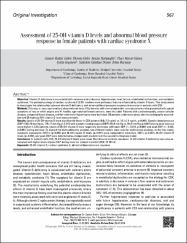Assessment of 25-OH vitamin D levels and abnormal blood pressure response in female patients with cardiac syndrome X

Göster/
Erişim
info:eu-repo/semantics/openAccessTarih
2016Yazar
Babür Güler, GamzeGüler, Ekrem
Hatipoğlu, Suzan
Güneş, Hacı Murat
Geçmen, Çetin
Demir, Gültekin Günhan
Barutçu, İrfan
Üst veri
Tüm öğe kaydını gösterKünye
Babür Güler, G., Güler, E., Hatipoğlu, S., Güneş, H. M., Geçmen, Ç., Demir, G. G. ... Barutçu, İ. (2016). Assessment of 25-OH vitamin D levels and abnormal blood pressure response in female patients with cardiac syndrome X. Anatolian Journal of Cardiology, 16(12), 961-966.Özet
Objective: Vitamin D deficiency is associated with coronary artery disease, hypertension, heart failure, endothelial dysfunction, and metabolic syndrome. The pathophysiology of cardiac syndrome X (CSX) involves many pathways that are influenced by vitamin D levels. This study aimed to investigate the relationship between vitamin D deficiency and abnormal blood pressure response to exercise in patients with CSX. Methods: This was a cross-sectional and observational study. Fifty females with normal epicardial coronary arteries who presented with typical symptoms of rest or effort angina and 41 healthy age-matched female controls, were included. Patients with cardiomyopathy, severe valvular disease, congenital heart disease, and left ventricular hypertrophy were excluded. All patients underwent stress electrocardiography examination and 25-hydroxy (OH) vitamin D level measurements. Results: Levels of 25-OH vitamin D were significantly lower in CSX patients (9.8±7.3 ng/mL vs. 18.1±7.9 ng/mL; p<0.001). Systolic blood pressure (SBP) (188±15 mm Hg vs. 179±17 mm Hg; p=0.013) and diastolic blood pressure (DBP) (98±9 mm Hg vs. 88±9 mm Hg; p<0.001) during peak exercise were higher in CSX patients. Levels of 25-OH vitamin D were negatively correlated with peak SBP (r=–0.310, p=0.004) and peak DBP (r=–0.535, p<0.001) during exercise. To discard the multicollinearity problem, two different models were used for multivariate analyses. In the first model, metabolic equivalents (METs) (p=0.003) and 25-OH vitamin D levels (p=0.001) were independent predictors. METs (p=0.007), 25-OH vitamin D levels (p=0.008), and peak DBP were determined as independent predictors in the second multivariate model. Conclusion: In patients with CSX, 25-OH vitamin D levels were lower than those in controls; moreover, 25-OH vitamin D deficiency was also associated with higher levels of peak DBP during exercise.
WoS Q Kategorisi
Q4Scopus Q Kategorisi
Q3Kaynak
Anatolian Journal of CardiologyCilt
16Sayı
12Bağlantı
https://hdl.handle.net/20.500.12511/1323https://dx.doi.org/10.14744/AnatolJCardiol.2016.6862

















